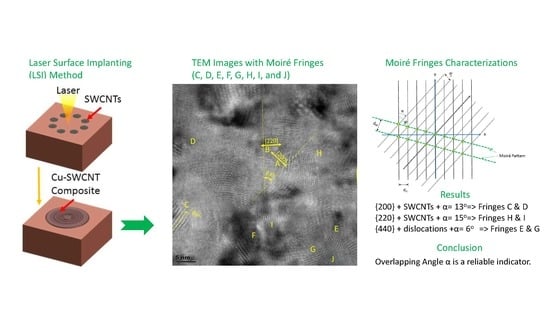TEM Nano-Moiré Pattern Analysis of a Copper/Single Walled Carbon Nanotube Nanocomposite Synthesized by Laser Surface Implanting
Abstract
:1. Introduction
1.1. Wet Synthesis of Cu–SWCNT Nanocomposite
1.2. Difficulties in TEM Characterization of the Cu–SWCNT Nanocomposite
1.3. Nano-Moiré Patterns in TEM Images
1.4. Hypothesis
2. Methods
2.1. Sample Preparation and Imaging
2.2. Modeling of Moiré Fringes
2.3. Measurement Errors Involved in Characterizing Moiré Patterns
2.4. Diffraction Patterning and Indexing via FFT
3. Results
3.1. TEM Images Showing Nano-Sized SWCNT Clusters within the Copper Matrix
3.2. Diffraction Patterns and Indexing
3.3. Moiré Fringes not Due to SWCNTs
3.4. Moiré Pattern Characterization
3.4.1. Pattern #1
3.4.2. Pattern #2
3.4.3. Pattern #3 Found in Pure Copper Samples
4. Discussion
5. Conclusions
Acknowledgments
Conflicts of Interest
References
- Iijima, S. Helical microtubules of graphitic carbon. Nature 1991, 354, 56–58. [Google Scholar] [CrossRef]
- Ajayan, P.M.; Zhou, O.Z. Applications of Carbon Nanotubes. In Carbon Nanotubes; Dresselhaus, M.S., Dresselhaus, G., Avouris, P., Eds.; Topics in Applied Physics; Spring: Berlin/Heidelberg, Germany, 2001; pp. 391–425. [Google Scholar]
- Endo, M.; Strano, M.S.; Ajayan, P.M. Potential Applications of Carbon Nanotubes. In Carbon Nanotubes; Jorio, A., Dresselhaus, G., Dresselhaus, M.S., Eds.; Topics in Applied Physics; Spring: Berlin/Heidelberg, Germany, 2007; pp. 13–62. [Google Scholar]
- Curtin, W.A.; Sheldon, B.W. CNT-reinforced ceramics and metals. Mater. Today 2004, 7, 44–49. [Google Scholar] [CrossRef]
- Carreño-Morelli, E. Carbon Nanotube–Metal Matrix Composites. In Dekker Encyclopedia of Nanoscience and Nanotechnology, 2ed Edition; CRC Press: Boca Raton, FL, USA, 2009; pp. 611–619. [Google Scholar]
- Agarwal, A.; Bakshi, S.R.; Lahiri, D. Carbon Nanotubes: Reinforced Metal Matrix Composites; CRC Press: Boca, FL, USA, 2011. [Google Scholar]
- Rajule, N. Laser Synthesis and Characterization of Copper-Single Walled Carbon Nanotubes Nanocomposites. Ph.D. Thesis, Department of Mechanical and Aerospace Engineering, North Carolina State University, Raleigh, NC, USA, 2014. [Google Scholar]
- Tu, J.F.; Rajule, R.; Molian, P.; Liu, Y. Laser synthesis of a copper–single-walled carbon nanotube nanocomposite via molecular-level mixing and non-equilibrium solidification. J. Phys. D Appl. Phys. 2016, 49, 495301. [Google Scholar] [CrossRef]
- Tu, J.F.; Rajule, N.; Liu, Y.; Martin, J. Nanostructure diffraction analysis of a copper/single walled carbon nanotube nanocomposite synthesized by laser surface implanting. Carbon 2017, 113, 1–9. [Google Scholar] [CrossRef]
- Hwang, C.; Geiss, R.H.; Howard, J.K. Imaging of the grain-to-grain epitaxy in NiFe/FeMn thin-film couples. J. Appl. Phys. 1988, 64, 6115–6117. [Google Scholar] [CrossRef]
- Poza, P.; Gomez-Garcia, J.; Munez, C.J. TEM analysis of the microstructure of thermal barrier coatings after isothermal oxidation. Acta Mater. 2012, 60, 7197–7206. [Google Scholar] [CrossRef]
- Zhang, X.; Meng, F.; Christianson, J.R.; Arroyo-Torres, C.; Lukowski, M.A.; Liang, D.; Schmidt, J.R.; Jin, S. Vertical heterostructures of layered metal chalcogenides by van der Waals Epitaxy. Nano Lett. 2014, 14, 3047–3054. [Google Scholar] [CrossRef] [PubMed]
- Zhang, H.; Wen, H.; Liu, Z.; Zhang, Q.; Xie, H. TEM nano-moiré evaluation for an invisible lattice structure near the grain interface. Nanoscale 2017, 9, 15923–15933. [Google Scholar] [CrossRef] [PubMed]
- Xie, H.; Liu, Z.; Fang, D.; Dai, F.; Gao, H.; Zhao, Y. A study on the digital nano-moiré method and its phase shifting techniques. Meas. Sci. Technol. 2004, 15, 1716–1721. [Google Scholar] [CrossRef]
- Link, T.; Epishin, A.; Brückner, U.; Portella, P. Increase of misfit during creep of superalloys and its correction with deformation. Acta Mater. 2000, 48, 1981–1994. [Google Scholar] [CrossRef]
- Ohnogi, H.; Isshiki, T.; Sasaki, S.; Sajurai, S. Intriguing transmission electron microscopy images observed for perpendicularly oriented cylindrical microdomains of block copolymers. Nanoscale 2014, 6, 10817–10823. [Google Scholar] [CrossRef] [PubMed]
- Luican, A.; Li, G.; Reina, A.; Kong, J.; Nair, R.R.; Novoselov, K.S.; Geim, A.K.; Andrei, E.Y. Single-layer behavior and its breakdown in Twisted graphene layers. Phys. Rev. Lett. 2011, 106, 12682. [Google Scholar] [CrossRef] [PubMed]
- Macdonald, A.H.; Bistritzer, R. Graphene moiré mystery solved? Nature 2011, 474, 453–454. [Google Scholar] [CrossRef] [PubMed]
- Brown, L.; Hovden, R.; Huang, P.; Wojcik, M.; Muller, D.A.; Park, J. Twinning and twisting of tri- and bilayer graphene. Nano Lett. 2012, 12, 1609–1615. [Google Scholar] [CrossRef] [PubMed]
- Robertson, A.W.; Warner, J.H. Atomic resolution imaging of graphene by transmission electron microscopy. Nanoscale 2013, 5, 4079–4093. [Google Scholar] [CrossRef] [PubMed]
- Kim, J.H.; Kim, K.; Lee, Z. The hide-and-seek of grain boundaries from moiré pattern fringe of two-dimensional graphene. Sci. Rep. 2015, 5, 12508. [Google Scholar] [CrossRef] [PubMed]
- Nepijko, S.; Klimenkov, M.; Adelt, M.; Kuhlenbeck, H.M.; Schlogl, R.; Freund, H.-J. Structural investigation of palladium clusters on γ-Al2O3/NiAl(110) with transmission electron microscopy. Langmuir 1999, 15, 5309–5313. [Google Scholar] [CrossRef]
- Oster, G.; Wasserman, M.; Zwerling, C. Theoretical interpretation of moiré patterns. J. Opt. Soc. Am. 1964, 54, 169–175. [Google Scholar] [CrossRef]
- Colomer, J.-F.; Henrard, L.; Lambin, P.H.; Van Tendeloo, G. Electron diffraction and microscopy of single-wall carbon nanotube bundles produced by different methods. Eur. Phys. J. B 2002, 27, 111–118. [Google Scholar] [CrossRef]
- Qin, L.-C. Electron Diffraction from Carbon Nanotubes. Rep. Prog. Phys. 2006, 69, 2761–2821. [Google Scholar] [CrossRef]

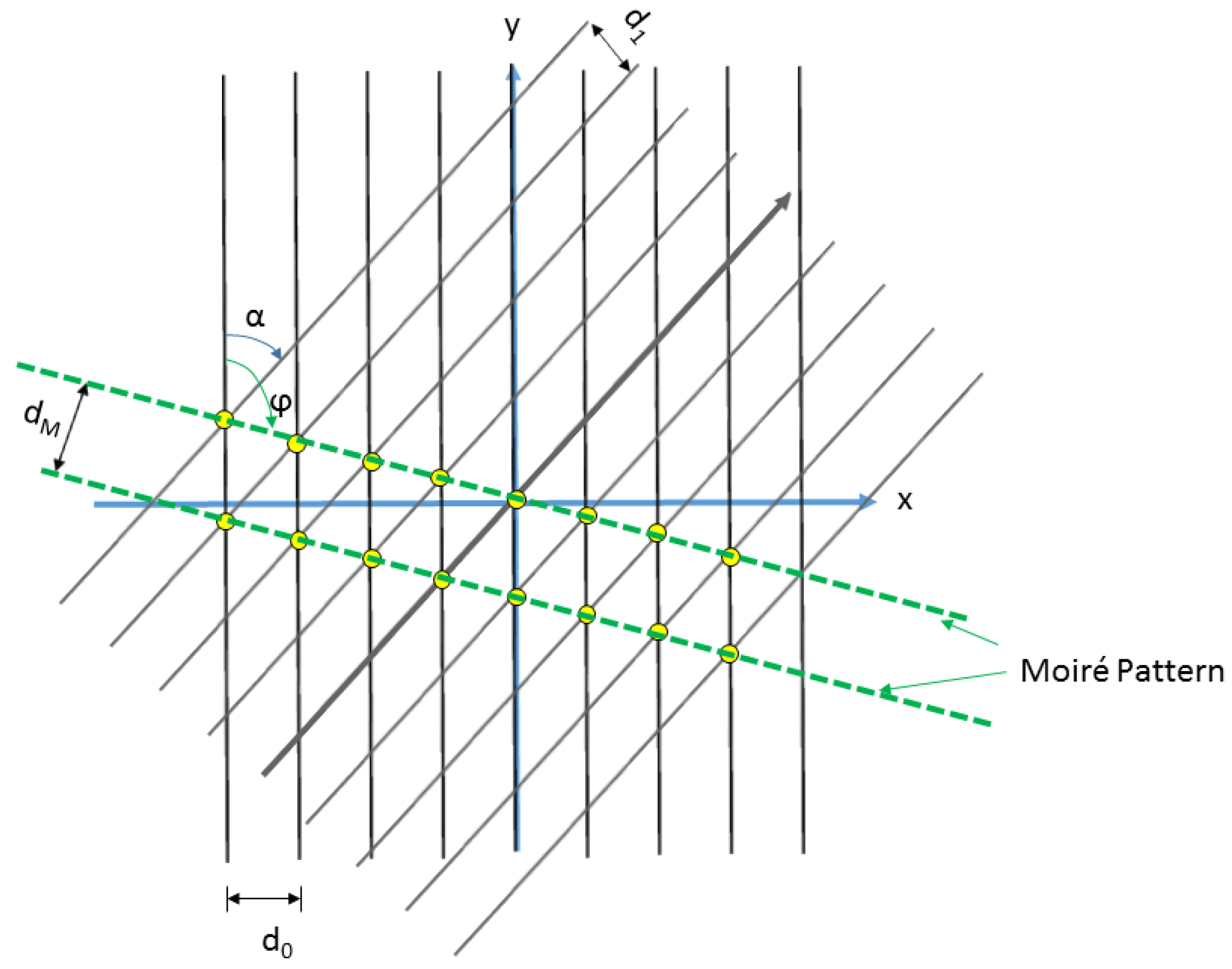
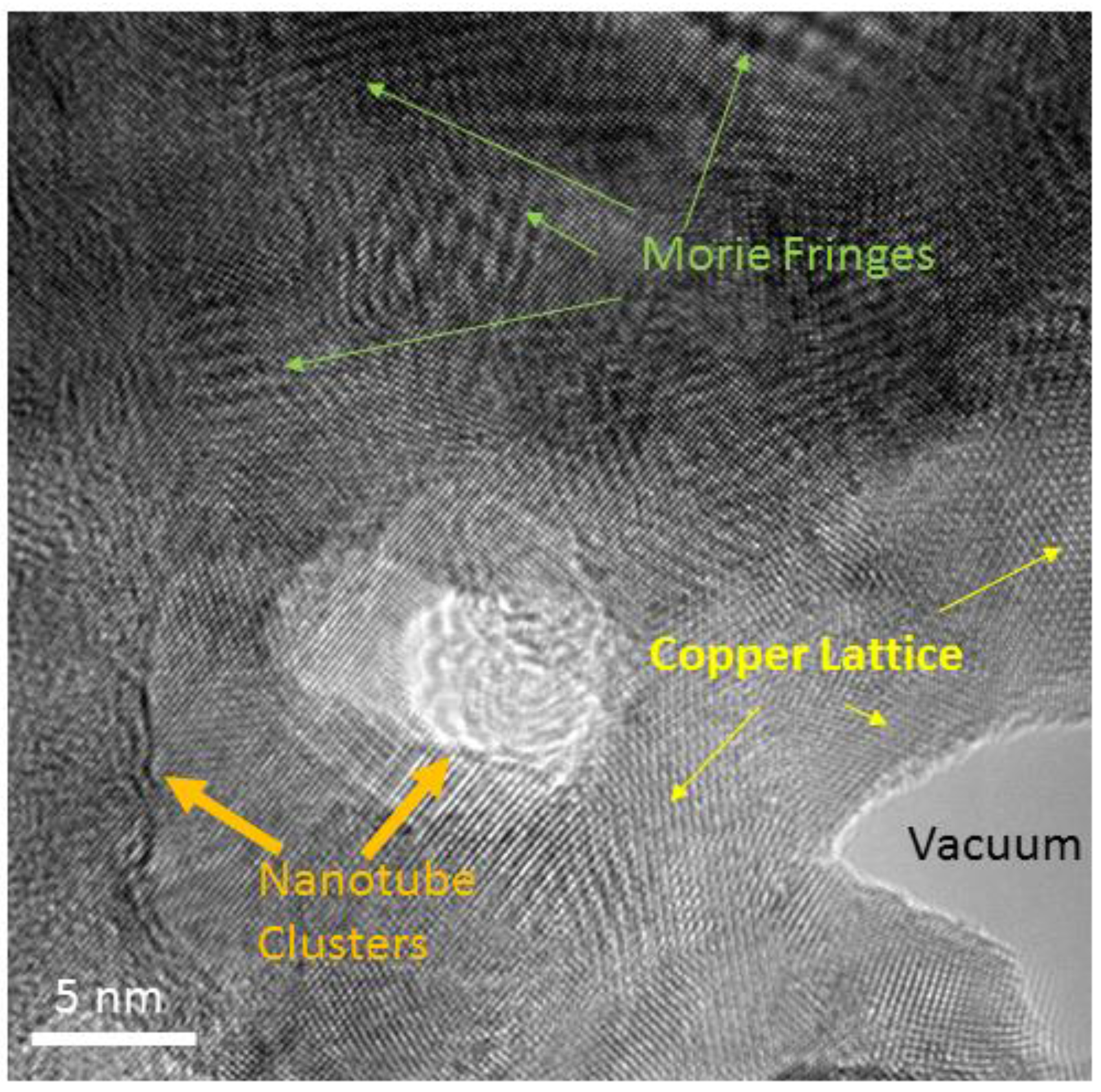
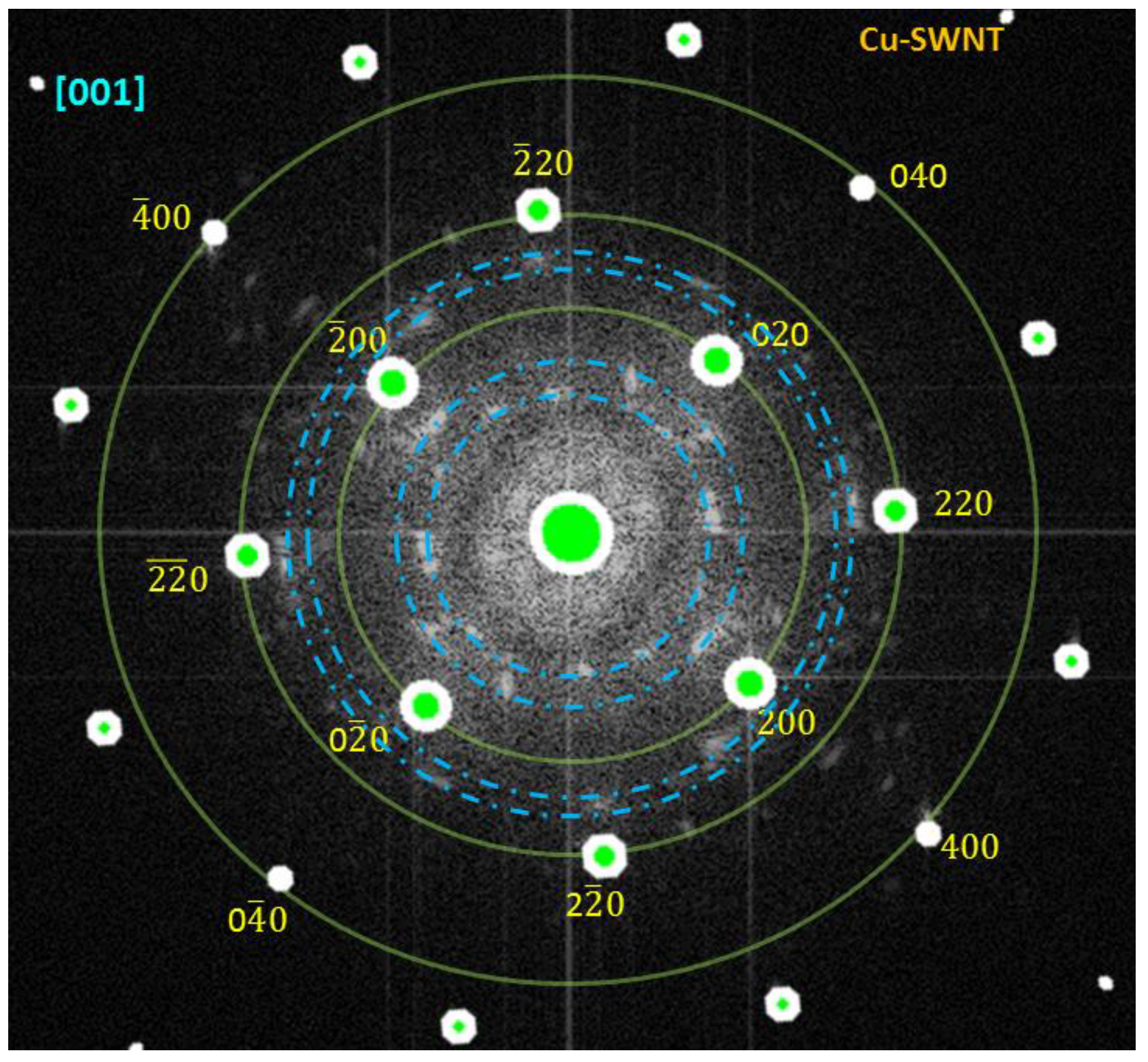
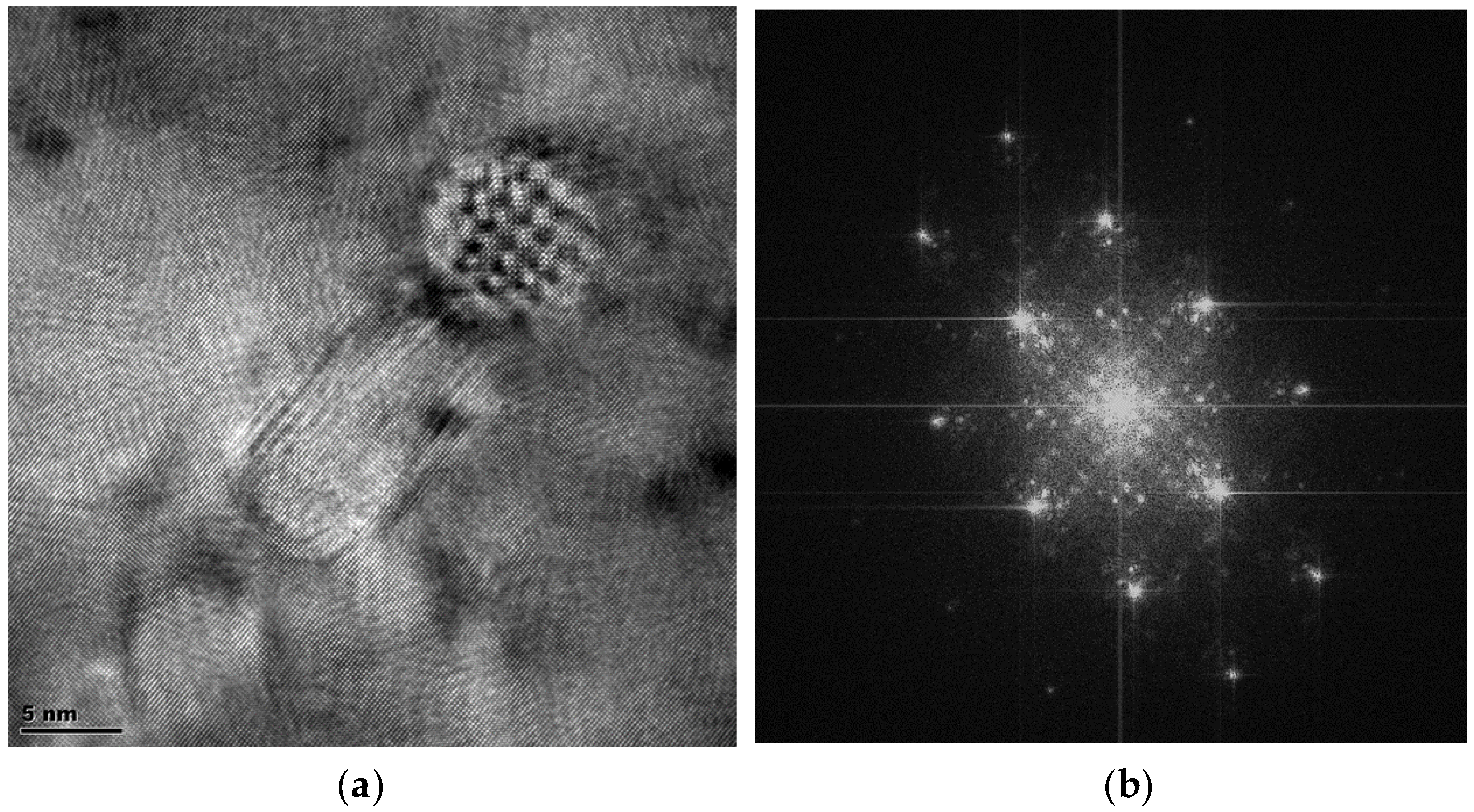
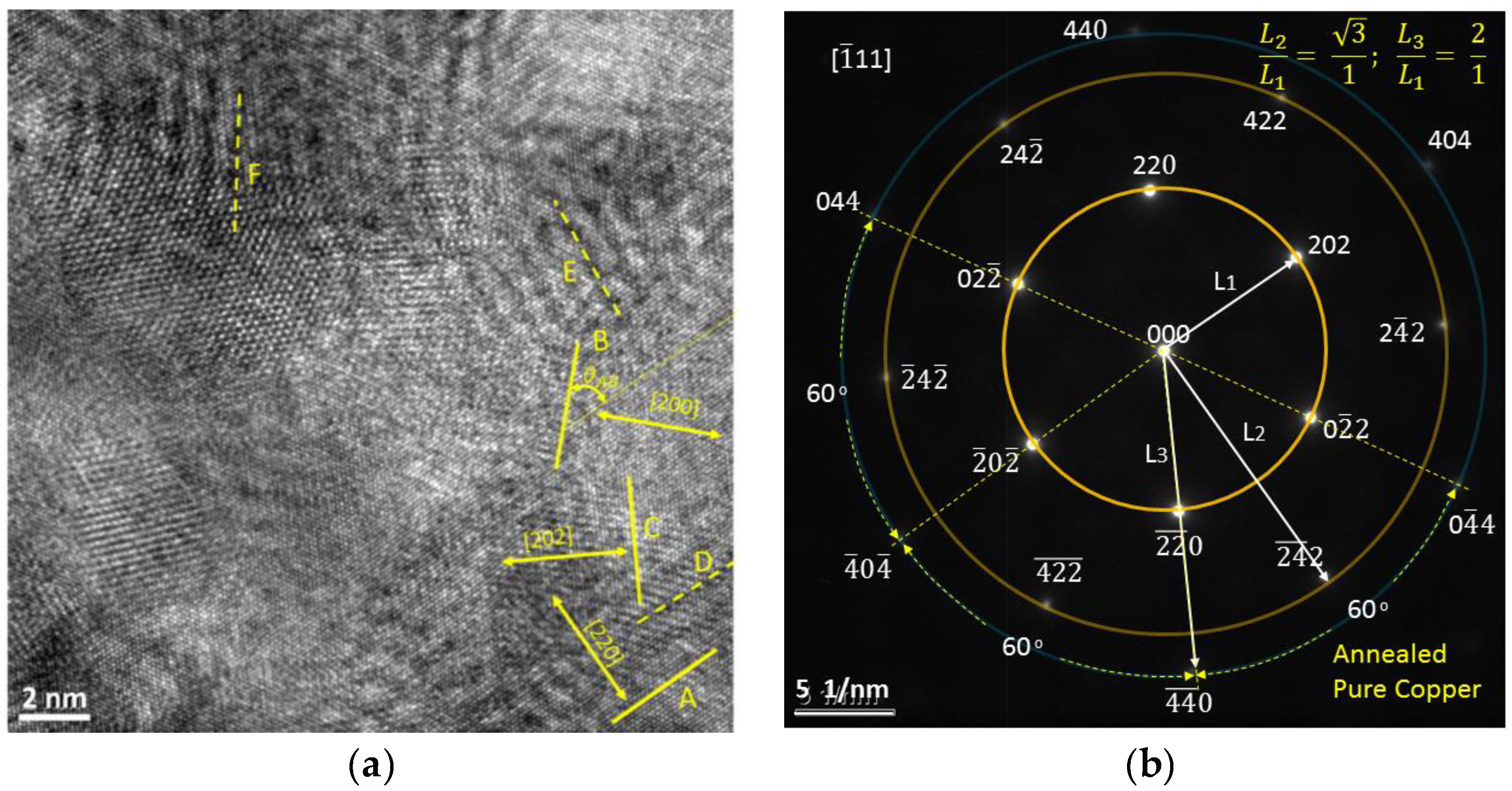


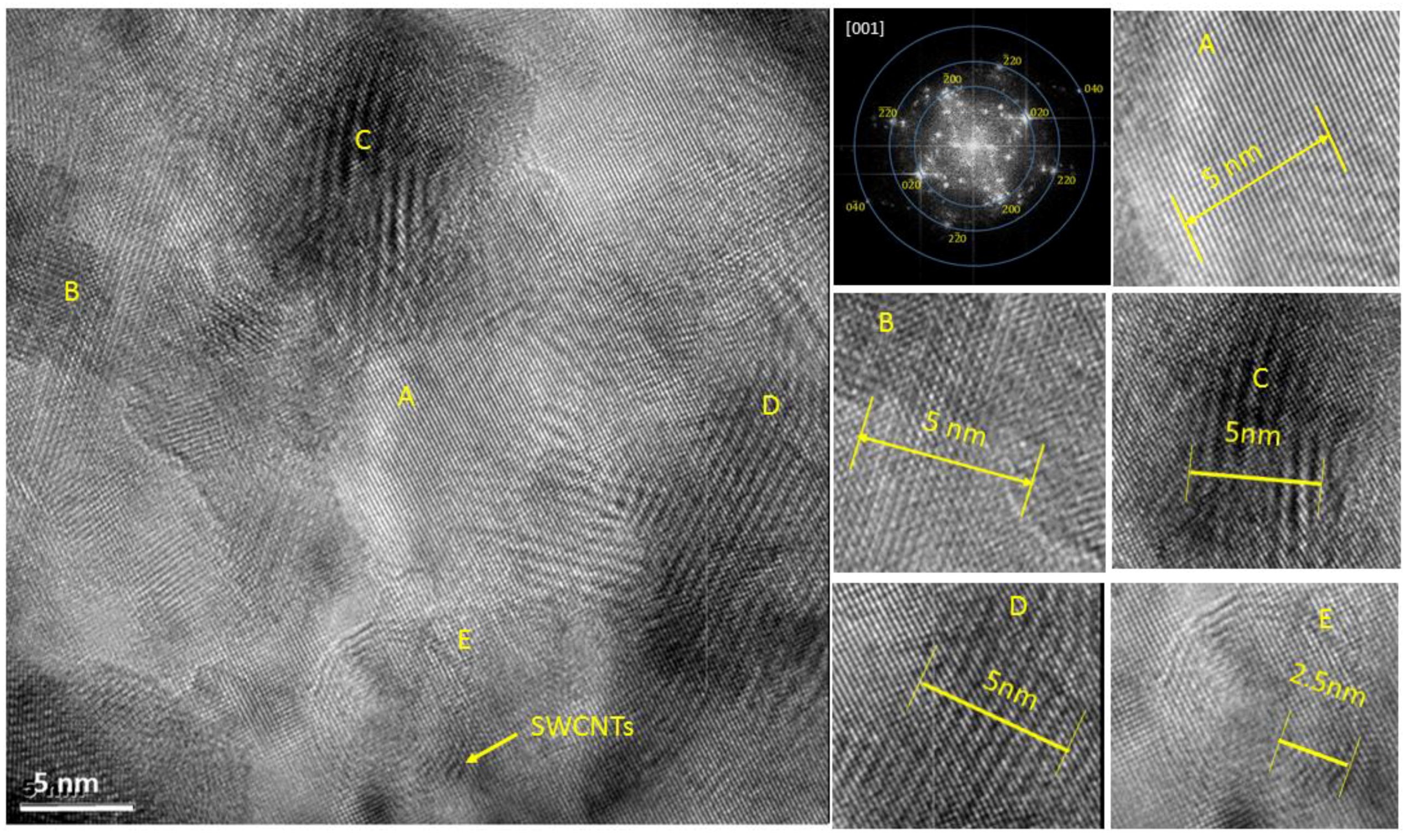
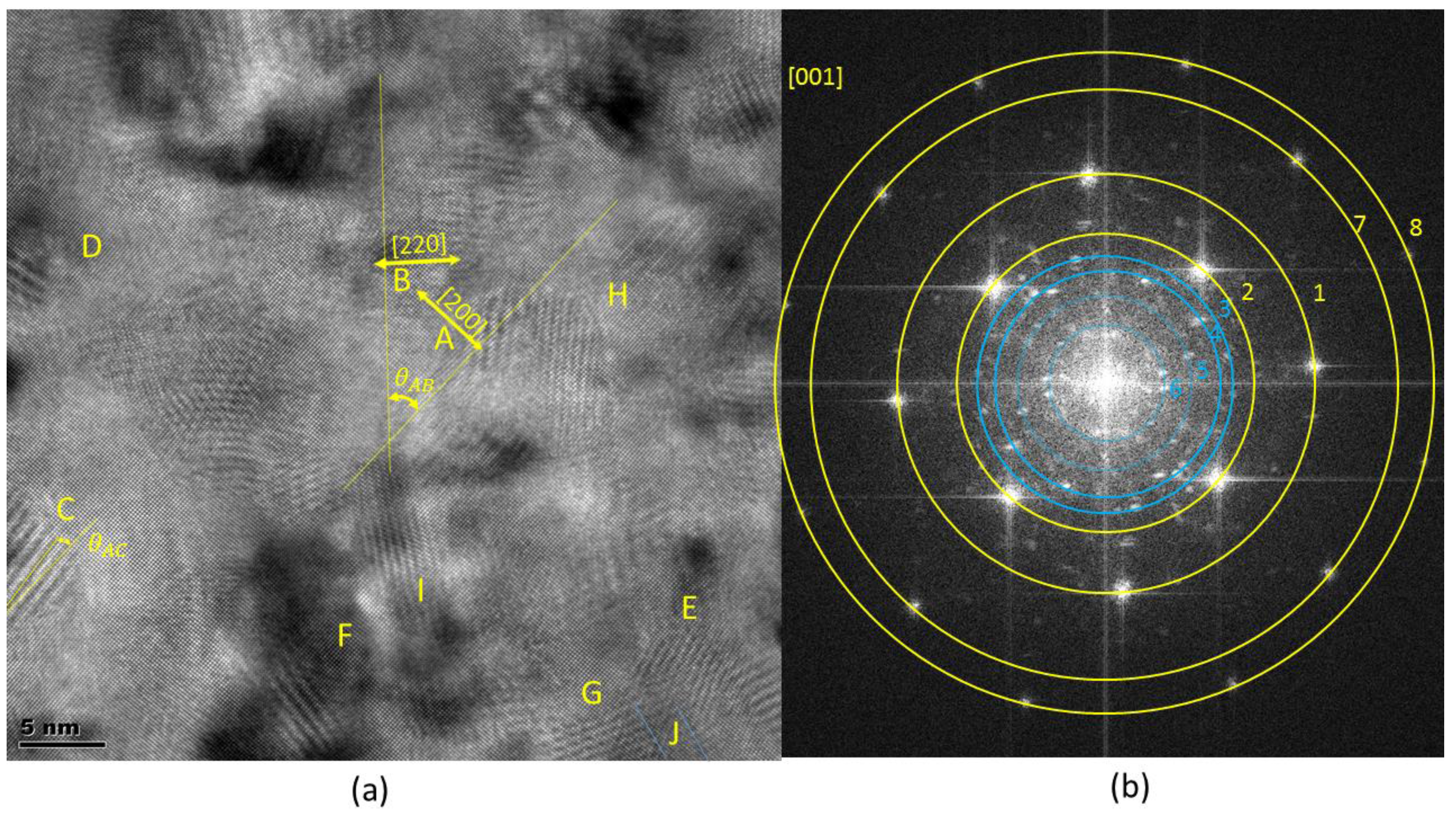
| Fringes Zone | A | B | C | D | E | F | G | H | I | J |
|---|---|---|---|---|---|---|---|---|---|---|
| Spacing, nm | 0.18 | 0.13 | 0.78 | 0.77 | 0.55 | 0.64 | 0.56 | 0.49 | 0.49 | 0.67 |
| ±0.02 nm | ||||||||||
| Angle | 0 | 45.0 | 4.3 | 94.2 | 21.6 | 78.9 | −29.4 | 37.6 | 51.2 | 86 * |
| ±0.1 degree |
| Ring # | 1 | 2 | 3 | 4 | 5 | 6 | 7 | 8 | |
|---|---|---|---|---|---|---|---|---|---|
| Lattice Family | {220} | {200} | - | - | - | - | {400} | {420} | {440} |
| Spacing (nm) | 0.1278 | 0.1807 | 0.21 | 0.24 | 0.31 | 0.47 | 0.090 | 0.081 | 0.064 |
| Fringes Zone | A | B | C | D | E | F |
|---|---|---|---|---|---|---|
| Spacing, nm | 0.13 | 0.18 | 0.13 | 0.91 | 0.87 | 0.91 |
| ±0.01 nm | ||||||
| Angle | 0 | 45.0 | 60.0 | −0.8 | 80.7 | 49.5 |
| ±0.1 degree |
© 2018 by the author. Licensee MDPI, Basel, Switzerland. This article is an open access article distributed under the terms and conditions of the Creative Commons Attribution (CC BY) license (http://creativecommons.org/licenses/by/4.0/).
Share and Cite
Tu, J.F. TEM Nano-Moiré Pattern Analysis of a Copper/Single Walled Carbon Nanotube Nanocomposite Synthesized by Laser Surface Implanting. C 2018, 4, 19. https://doi.org/10.3390/c4010019
Tu JF. TEM Nano-Moiré Pattern Analysis of a Copper/Single Walled Carbon Nanotube Nanocomposite Synthesized by Laser Surface Implanting. C. 2018; 4(1):19. https://doi.org/10.3390/c4010019
Chicago/Turabian StyleTu, Jay F. 2018. "TEM Nano-Moiré Pattern Analysis of a Copper/Single Walled Carbon Nanotube Nanocomposite Synthesized by Laser Surface Implanting" C 4, no. 1: 19. https://doi.org/10.3390/c4010019




